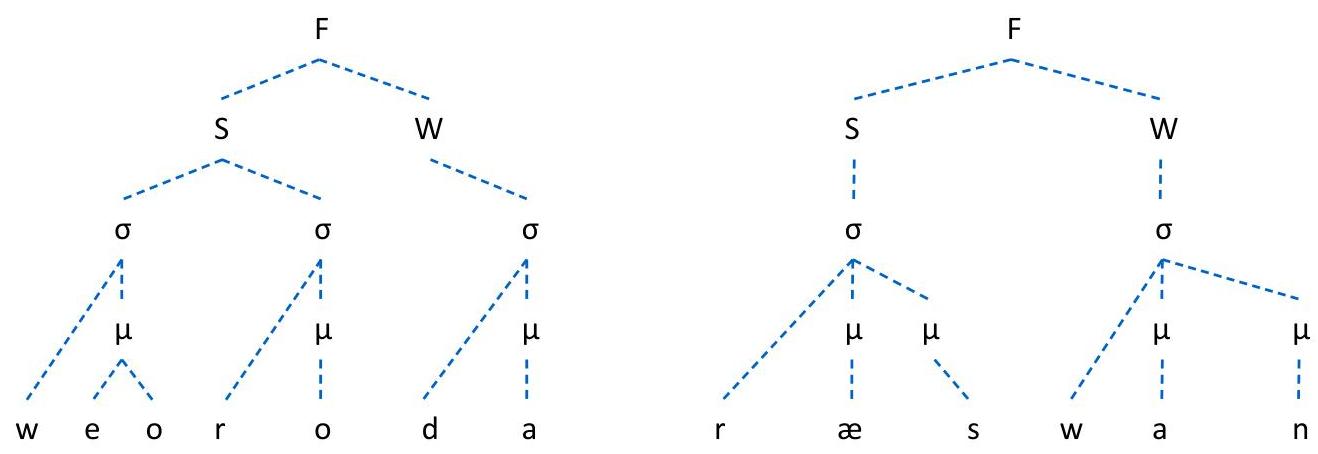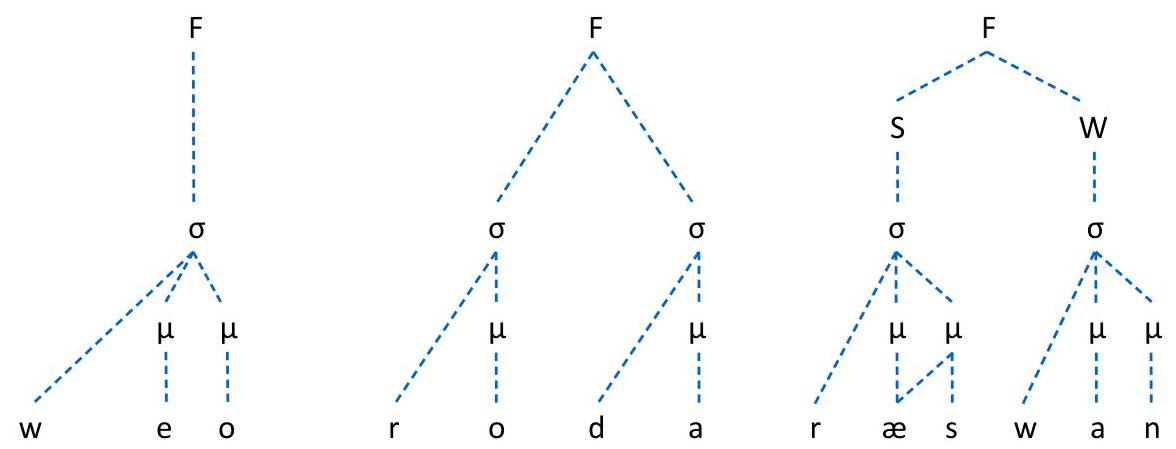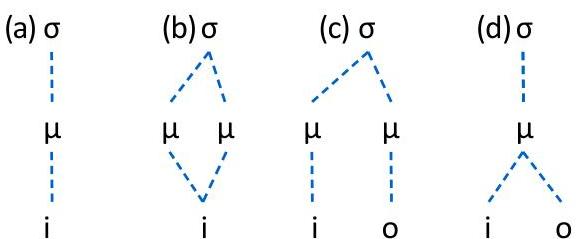2017. Sobol. Against Old English short diphthongs.pdf (original) (raw)
36 CROSSROADS A Journal of English Studies
ISSUE 16
1/2017
An electronic journal published by The University of Bialystok
ISSUE 16
1/20171 / 2017

QK CROSSROADS
Publisher:
The University of Bialystok
The Faculty of Philology
Department of English
ul. Liniarskiego 3
15-420 Białystok, Poland
tel. 0048857457516
@crossroads@uwb.edu.pl
@ www.crossroads.uwb.edu.pl
e-ISSN 2300-6250
The electronic version of Crossroads. A Journal of English Studies
is its primary (referential) version.
Editor-in-chief:
Agata Rozumko
Literary editor:
Grzegorz Moroz
Editorial Board:
Sylwia Borowska-Szerszun, Zdzisław Głębocki, Jerzy Kamionowski, Daniel Karczewski, Ewa Lewicka-Mroczek, Weronika Łaszkiewicz, Kirk Palmer, Jacek Partyka, Dorota Potocka, Dorota Szymaniuk, Anna Tomczak, Daniela Francesca Virdis, Beata Piecychna
Editorial Assistant:
Ewelina Feldman-Kołodziejuk
Language editors:
Kirk Palmer, Peter Foulds
Advisory Board:
Pirjo Ahokas (University of Turku), Lucyna Aleksandrowicz-Pędich (SWPS: University of Social Sciences and Humanities), Ali Almanna (Sohar University), Isabella Buniyatova (Borys Ginchenko Kyiev University), Xinren Chen (Nanjing University), Marianna Chodorowska-Pilch (University of Southern California), Zinaida Charytończyk (Minsk State Linguistic University), Gasparyan Gayane (Yerevan State Linguistic University “Bryusov”), Marek Gołębiowski (University of Warsaw), Anne-Line Graedler (Hedmark University College), Cristiano Furiassi (Università degli Studi di Torino), Jarosław Krajka (Maria Curie-Skłodowska University / University of Social Sciences and Humanities), Marcin Krygier (Adam Mickiewicz University), A. Robert Lee (Nihon University), Elżbieta Mańczak-Wohlfeld (Jagiellonian University), Zbigniew Maszewski (University of Łódź), Michael W. Thomas (The Open University, UK), Sanae Tokizane (Chiba University), Peter Unseth (Graduate Institute of Applied Linguistics, Dallas), Daniela Francesca Virdis (University of Cagliari), Valentyna Yakuba (Borys Ginchenko Kyiev University)
Contents
4 ARTICLES
4 Michał Daszkiewicz
Do English learners from different countries approach (“compose”) topics differently?
A study report
19 Rana A. Saeed Almaroof
The effect of transparency on a three-cycle model of manipulative discourse
32 Helena Sobol
Against Old English ‘short’ diphthongs
40 WORK IN PROGRESS
41 Agata Szulkowska
The problem of racism in Kathryn Stockett’s novel The Help
54 NOTE ON CONTRIBUTORS
Against Old English ‘short’ diphthongs
Abstract
Since the earliest grammars, Old English has been analysed as having a length contrast in diphthongs, containing both regular, bimoraic ones, side by side with cross-linguistically unique monomoraic ones. The supposedly monomoraic diphthongs [io eo æa] arose through back umlaut and breaking. Unsurprisingly, they have become the source of possibly the greatest controversy in OE phonology, which still remains unresolved. The present paper refutes the main arguments for a length contrast in OE diphthongs. Instead, it argues for a generative phonological analysis, where the diphthongs constitute monomoraic monophthongs in the underlying representation, and bimoraic diphthongs in the surface representation.
Keywords: Old English, short diphthongs, syllable weight, back umlaut, breaking.
Since the earliest grammars, Old English has been analysed as having a length contrast in diphthongs, containing both regular, bimoraic ones, side by side with cross-linguistically unique monomoraic ones. The supposedly monomoraic diphthongs [io eo æa] arose through processes known as back umlaut and breaking, cf. the data in (1) and (2). Unsurprisingly, they have become the source of possibly the greatest controversy in Old English phonology (systematically summarised in Lass & Anderson 1975: 75-79), which still remains unresolved. It ought to be noted, however, that the problem of ‘short diphthongs’ in Old English is so complex that it cannot be solved comprehensively in a journal article. Instead, the present paper attempts at suggesting a solution within generative phonology. Namely, the diphthongs are suggested to constitute monomoraic monophthongs in the underlying representation, and bimoraic diphthongs in the surface representation.
(1) Old English back umlaut 1{ }^{1}
| before /u/ | before /o/ | |
|---|---|---|
| /i/ | *sifun > *siofun > siofon ‘seven’; writ ‘a writing’ ∼\sim gewriotu ‘writings’ | *niða- > *nioða- > nioðemest ‘lowest’; lifian ‘to live’ liofað ‘he lives’ |
| /e/ | *hefun > *heofun > heofon ‘heaven’; ete ‘eat (pres. subj. sg.)’ eotu’l eat’ | fela feola ‘many (indecl.)’; etan eotan ‘to eat’ |
| /æ/ | fæt ‘vessel’ fatu (nom. pl.); hwæt ‘active’ (nom. sg.) hwwatum (dat. sg./ pl.) | hwæle ‘whale’ (dat. sg.) hwalas (nom. pl.); fære ‘go’ (imp. sg.) faran (inf.) |
(2) Old English breaking
| (a) before /r/:/ \mathrm{r} /: | Pre-OE *hærd > OE heard ‘hard’, Pre-OE *sterra > OE steorra ‘star’, OE birhtu beorhtu (< *biorhtu) ‘brightness’; |
|---|---|
| (b) before /I/:/ \mathrm{I} /: | Pre-OE *æll > OE eall ‘all’, OE self seolf ‘self’, Pre-OE *silfr > OE siolfor ‘silver’; |
| © before /w/:/ \mathrm{w} /: | Pre-OE *pæ̈w > OE béaw ‘custom’, Pre-OE *mēwle > OE mēowle ‘maiden’, OE hiw hiow ‘shape’; |
| (d) before /x/:/ \mathrm{x} /: | Pre-OE *sæh > OE seah ‘he saw’, Pre-OE *næ̈h > OE nēah ‘near’, Pre-OE *fehtan > OE feohtan ‘fight’, OE wiht wioht ‘creature’ (Kentish), OE líht lioht ‘light, n.’ (Kentish). |
The source of the controversy lies in that those diphthongs seemingly function in the language like short vowels. For instance, the assumption of ‘short’ diphthongs allows for a fully regular scansion of lines such as Beowulf 1. 60b: weoroda ræswan ‘the counsellors of troops’. 2{ }^{2} The half-line scans as a perfect Sieversian (1893) A-type verse, with the first lift resolved over the initial two syllables (L_X X | H X) if and only if the initial syllable of weoroda remains monomoraic. 3{ }^{3} The relevant foot structure in the ‘Germanic foot’ system of Dresher & Lahiri (1991) is shown in (2) below.
- 1 Standard descriptions of back umlaut and breaking include Luick (1921: 133−153,220,224−234\$ \$ 133-153,220,224-234 ), Campbell (1959: 139−163,205−221\$ \$ 139-163,205-221 ), Lass & Anderson (1975: 74-112), and Hogg (1992: 5.16−5.27,5.103−5.107\$ \$ 5.16-5.27,5.103-5.107 ).
2 Quotations from Beowulf follow Dobbie’s (1953) edition. Macrons have been added above long monophthongs and indisputably bimoraic diphthongs.
3 The notation uses the following symbols: H - heavy syllable, L - light syllable, X - syllable of unspecified weight, - accented syllable, | - foot boundary. ↩︎
(2) Prosodic structure of Beowulf 1. 60b weoroda rā̄swan ‘the counsellors of troops’, according to the ‘Germanic foot’ theory of Dresher & Lahiri (1991)
The majority of Old English poetical half-lines belong to this type, which may be described as two consecutive trochees. Any aberration from the basic pattern would be linguistically marked, and especially so in the b-verse, which always adheres to the metrical types far more strictly than the a-verse. However, the basic pattern of two consecutive trochees would founder in the quoted line if the diphthong received two moras, as in (3).
(3) Prosodic structure of Beowulf 1. 60b weoroda rā̄swan ‘the counsellors of troops’, without ‘short’ diphthongs
The prosodic structure of (3) is (H L˙X∣H′X\left.\begin{array}{l}\dot{\mathrm{L}} \mathrm{X}\end{array}\right| \mathrm{H}^{\prime} \mathrm{X} ), which cannot be easily accommodated within any of the types defined by Sievers. 4{ }^{4} Therefore, such half-lines have constituted primary evidence for positing short diphthongs as the surface representation of the results of back umlaut and breaking
- 4 The grave accent over L˙\dot{\mathrm{L}} signifies secondary stress, as opposed to primary stress marked with the acute accent. ↩︎
on short vowels. However, not all instances of the relevant digraphs in poetry yield more regular scansion if interpreted as monomoraic nuclei. Sievers (1893: 7777\77 77 ) already pointed out that at times these must be analysed as phonetically long, though without examples of poetic half-lines where that is the case. Nonetheless, examples can be easily found; for instance Beowulf 1. 489 Site nû tô symle / ond onsêl meoto ‘Now sit down to the feast and unseal the food (i.e. start eating)’. If meoto ‘food’ is analysed to have a monomoraic diphthong, the verse scans as ( XXH∣LX\mathrm{X} \mathrm{X} \mathrm{H} \mid \mathrm{L} \mathrm{X} ). In Sieversian classification, such verses belong to the C-type, whose canonical form is ( XH∣H′X\mathrm{X} \mathrm{H} \mid \mathrm{H}^{\prime} \mathrm{X} ). In this case, the verse has the first dip expanded by a single syllable, which is allowed in the off-verse, and suspends resolution in the second lift. Such a half-line structure occurs frequently enough to have gained recognition as one of the possible subtypes (see for instance Fulk 2001). However, if the initial syllable of meoto is bimoraic, then the verse would scan as ( XXH∣H′X\mathrm{X} \mathrm{X} \mathrm{H} \mid \mathrm{H}^{\prime} \mathrm{X} ), without the need for suspended resolution in the second foot. What is more, Sievers (1893: 7777\77 77 ) also notes that some diphthongs resulting from back umlaut or breaking of short vowels were long in all contexts, e.g. PrGmc *faw- > OE fêawa ‘few’. Hence, metrical data cannot be taken as unambiguously supportive of the theory of ‘short’ diphthongs.
The other argument commonly adduced in favour of ‘short’ diphthongs in Old English is that their later English reflexes apparently pattern together with etymological short vowels rather than long ones, as shown in (4).
(4) Later reflexes of Old English ‘long’ and ‘short’ diphthongs
| long in OE | short in OE | |
|---|---|---|
| /i i: io/ | OE wîf ‘woman’ > PDE wife /'wazf/; OE flond ‘enemy’ > PDE fiend /'fi:nd/ | OE brim ‘surface of the sea’ > PDE brim /'brım/; OE siolfur 'silver > PDE silver /'sılva/ |
| /e e: eo/ | OE dêman ‘to judge’ > PDE deem /'di:m/; OE dêop ‘deep’ > PDE deep /'di:p/ | OE men ‘men’ > PDE men /'men/; OE heofon ‘heaven’ > PDE heaven /'hevn/ |
| /æ æ: æa/ | OE ræ̃dan ‘to counsel; to read’ > PDE read /'ri:d/; OE drêam ‘joy’ > PDE dream /'dri:m/ | OE sæt ‘sat’ > PDE sat /'sæt/; OE weallan ‘to well’ > PDE well /'wel/ |
The examples in (4) have been chosen so that no phonological processes would change vowel length after the Old English period. The data above show that etymologically bimoraic vowels and diphthongs, both those inherited from Proto-Germanic and those newly created through breaking, emerge in Present Day English with either the long vowel /i:/ or its Great Vowel Shift cognate /aI/, both uncontroversially bimoraic. The two vowel phonemes /i: aI/ constitute the only two possible PDE reflexes of OE etymologically bimoraic front vowels and diphthongs beginning with a
front vowel whenever no process changed the vowel length. 5{ }^{5} On the other hand, etymologically monomoraic diphthongs seem to survive in PDE with short vowels, cf. the stressed syllables in silver, heaven, well - just as do the PDE reflexes of etymologically monomoraic vowels, for instance, brim, men, sat.
However, the latter generalisation takes into consideration only part of the data. While OE heofon >> PDE heaven has kept the initial syllable monomoraic, the very similar OE beofor ‘beaver’ >> PDE beaver /'bi:və/ has lengthened its stressed syllable. No generalisation can account for both PDE reflexes of OE words, because of their mutually contradictory development. Previous research (for instance, Luick 1921: 391\$ \$ 391-394; Dresher & Lahiri 1991: 281-282) suggests that words such as beofor underwent Open Syllable Lengthening, a Late Old English / Early Middle English process of mora insertion into the stressed syllable: ’ (C)VpCVp(p)−>(C)VppCVp(p)(\mathrm{C}) \mathrm{V}^{\mathrm{p}} \mathrm{CV}^{\mathrm{p}(\mathrm{p})}->(\mathrm{C}) \mathrm{V}^{\mathrm{pp}} \mathrm{CV}^{\mathrm{p}(\mathrm{p})}-. On the other hand, words such as heofon simply failed to undergo the lengthening.
This account may be largely correct, but it glosses over major dialectal discontinuities between Early Old English and Present Day English. In fact, Early Old English is mainly attested in Anglian (i.e. Northumbrian and Mercian) dialects, Late Old English in West Saxon. No standard can be discerned for Early Middle English, while in Late Middle English there emerged the London standard, based mainly on the Midland variety, a direct descendant of OE Anglian, yet with some Kentish features. Crucially, the three OE dialect families - Anglian, West Saxon, and Kentish differ in their treatment of the diphthongs under consideration. Therefore, the argument from the later standard English reflexes of the OE ‘short’ diphthongs cannot be valid, because the standard dialects do not descend from each other in an unbroken line.
The Present Day English reflexes of the ‘short’ diphthong examples in (4), especially siolfur and heofon, point to the attrition of the diphthongisation rules, since the modern forms, silver and heaven, preserve the OE front vowel intact, as if no diphthongisation took place. This has prompted Daunt (1939) to interpret the phenomenon in question not as phonological diphthongisation, but as purely graphical addition of a diacritic in the form of a back vowel letter, whose function was to mark the ‘back’ quality of the following consonant. The logic behind such reasoning is that if breaking and back umlaut left no diachronic trace, then maybe they did not constitute sound changes. Because of the dialectal discontinuities described above, it is difficult to adduce credible data from direct descendants of the dialects with more abundant diphthongisation, i.e. West Saxon and Kentish. Fortunately, the needed evidence can be found in place names preserved in medieval documents from the Southwestern dialectal area of Middle English (the direct descendant of OE West Saxon).
- 5 For description of the relevant shifts in long vowel quality, see the classic grammatical account in Luick (1940: \$ \$ 479-501), as well as the famous discussion in Stockwell & Minkova (1988a; 1988b) and Lass (1988). ↩︎
(5) Place name evidence for Southwestern ME reflexes of the ‘short’ diphthong spelled , after Kuhn & Quirk (1953: 150)
WS -bearu ‘grove’ > Estharabyar, Trendelbiare, Wydebyer;
WS healh ‘place’ > la Hyele, la Hyales; 6{ }^{6}
WS fearn- ‘fern’ > Fiernham;
WS fealw- ‘fallow’ > Vialepitte;
WS dealla- ‘proud, eminent’ > Dyalediche;
WS pearroc- ‘enclosure’ > Piarrecumbe.
All ME spellings in (5) represent the reflex of the ‘short’ diphthong [æa] with digraphs consisting of either ⟨i⟩\langle\mathrm{i}\rangle or ⟨y⟩\langle\mathrm{y}\rangle, followed by ⟨e⟩\langle\mathrm{e}\rangle or ⟨a⟩\langle\mathrm{a}\rangle. The obvious interpretation of these digraphs is that they stand for diphthongs whose first element can only be /i/, while their second element might be any of the ME non-high unrounded vowels /e ε\varepsilon a ə/. The spelling of the ME reflexes of the OE short monophthongs do not point towards any regular diphthongal development. Hence, the OE digraphs must have also represented diphthongs rather than monophthongs followed by a diacritic. They must have been bimoraic, since, to the best of my knowledge, no ‘short’ diphthongs have yet been posited for ME, or any other stage of the historical development of the English language.
Some scholars (for instance, Lass 1983: 53-58, followed by Hogg 1992: § 2.29) have attempted to save the theory of ‘short’ diphthongs by agreeing to the diphthongal quality of these vowels, but denying them the second mora, as in (6).
(6) The hypothetical fourfold contrast of vowel types in OE
- 6 The gloss for healh gives only approximate meaning for this ambiguous noun, discussed by the dictionary entries in Bosworth & Toller (1898) and Toller (1921). ↩︎
Figure (6) shows the monomoraic monophthong (6a) /i/, the bimoraic monophthong (6b) /i:/, the bimoraic diphthong (6c) /io/, and the hypothetical monomoraic diphthong (6d) /io/. The latter structure has been traditionally interpreted as a sequence of a monomoraic vowel followed by a ‘glide’ of uncertain quality (Campbell 1959: § 139; Minkova 2014: 179-180). Yet such an understanding of the theory of ‘short’ diphthongs cannot be accommodated into the basic phonological assumptions about Germanic syllables. This is because Germanic languages are highly weightsensitive, universally preferring the stressed syllable to be heavy. For stress-related issues, as well as other phonological processes, both CVV and CVC syllables must be interpreted as heavy. A CVV syllable is heavy due to its underlying two moras attached to the vowel, while a CVC syllable has one underlying mora attached to the vowel, plus a derived, second mora attached to the coda consonant through Weight-by-Position (Hayes 1989). Consequently, if a diphthong or vowel-glide sequence is not supposed to obtain a second mora, it requires the suspension of Weight-by-Position. Such a suspension has been posited for word-final consonants, so that final, unstressed syllables remain monomoraic; see, for instance, Kiparsky (1998: 6). However, both breaking and back umlaut operate (primarily) on stressed syllables, also in polysyllabic words, the canonical context for Weight-by-Position. Suspending it there would derive incorrect outputs for the whole system of OE phonology. 7{ }^{7}
Thus, the OE ‘short’ diphthongs need a representation that would encode both their diphthongal, and hence necessarily bimoraic structure, and their diachronic and synchronic propensity to pattern together with monomoraic vowels. Generative phonology offers a solution for such cases: these vowels ought to be represented as monomoraic monophthongs in the underlying representation and bimoraic diphthongs on the surface.
References
Bosworth, Joseph and Thomas Northcote Toller. 1898. An Anglo-Saxon Dictionary. Oxford: Clarendon.
Campbell, Alistair. 1959. Old English Grammar. Oxford: Clarendon.
Daunt, Marjorie. 1939. Old English sound changes reconsidered in relation to scribal tradition and practice. Transactions of the Philological Society 38. 108-137.
Dobbie, Elliott Van Kirk. 1953. Beowulf and Judith. New York: Columbia University Press.
Dresher, B. Elan and Aditi Lahiri. 1991. The Germanic foot: Metrical coherence in Old English. Linguistic Inquiry 22. 251-286.
Fulk, Robert D. 2001. Old English versification. In: John C. Pope, Eight Old English Poems. 3rd 3^{\text {rd }} ed., 129-158. New York/London: W.W. Norton.
Hayes, Bruce. 1989. Compensatory lengthening in moraic phonology. Linguistic Inquiry 20. 253-306. Hogg, Richard M. 1992. A Grammar of Old English. Vol. 1: Phonology. Oxford: Blackwell. Kiparsky, Paul, 1998. Sievers’ Law as prosodic optimization. Manuscript. Stanford University.
- 7 For other systematic counterarguments against ‘short’ diphthongs, see White (2004). ↩︎
Kuhn, Sherman M. and Randolph Quirk. 1953. Some recent interpretations of Old English digraph spellings. Language 29. 143-156.
Lass, Roger and John M. Anderson. 1975. Old English Phonology. Cambridge: Cambridge University Press.
Lass, Roger. 1983. Quantity, resolution, and syllable geometry. Folia Linguistica Historica 4. 151-180.
Lass, Roger. 1988. Vowel Shifts, great and otherwise: Remarks on Stockwell and Minkova. In: Dieter Kastovsky and Gero Bauer (eds.), Luick revisited. Papers read at the Luick-Symposium at Schloß Liechtenstein, 15-18.09.1985, 395-410. Tübingen: Gunter Narr.
Luick, Karl. 1921. Historische Grammatik der englischen Sprache. 1. Bd. Leipzig: Bernhard Tauchnitz.
Luick, Karl. 1940. Historische Grammatik der englischen Sprache. 2. Bd. Leipzig: Bernhard Tauchnitz.
Minkova, Donka. 2014. A Historical Phonology of English. Edinburgh: Edinburgh University Press. Sievers, Eduard. 1893. Altgermanische Metrik. Halle: Max Niemeyer.
Stockwell, Robert P. and Donka Minkova. 1988a. The English Vowel Shift: problems of coherence and explanation. In: Dieter Kastovsky and Gero Bauer (eds.), Luick Revisited. Papers Read at the Luick-Symposium at Schloß Liechtenstein, 15-18.09.1985, 355-394. Tübingen: Gunter Narr.
Stockwell, Robert P. and Donka Minkova. 1988b. A rejoinder to Lass. In: Dieter Kastovsky and Gero Bauer (eds.), Luick Revisited. Papers Read at the Luick-Symposium at Schloß Liechtenstein, 15-18.09.1985, 411-417. Tübingen: Gunter Narr.
Toller, Thomas Northcote. 1921. An Anglo-Saxon Dictionary. Supplement. Oxford: Clarendon.
White, David L. 2004. Why we should not believe in short diphthongs. In: Anne Curzan and Kimberly Emmons (eds.), Studies in the History of the English Language II. Unfolding Conversations, 57-84. Berlin/New York: Mouton de Gruyter.
